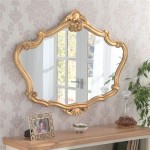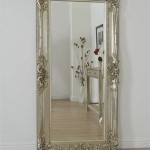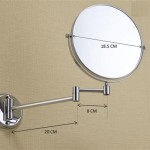Steel Frame Mirrors: A Comprehensive Guide
Steel frame mirrors represent a popular choice for both residential and commercial spaces, offering a blend of durability, versatility, and modern aesthetics. Understanding the various aspects of steel frame mirrors, from material composition to design considerations, can assist in making informed purchasing decisions.
The core component of a steel frame mirror is, naturally, the steel frame. Steel, an alloy primarily composed of iron and carbon, provides substantial strength and resistance to damage. Manufacturers often employ various steel types, including stainless steel, mild steel, and galvanized steel, each offering specific properties. Stainless steel, known for its corrosion resistance, is a premium choice for bathrooms and other humid environments. Mild steel, while more susceptible to rust, offers excellent weldability and formability, making it suitable for intricate frame designs. Galvanized steel, coated with a layer of zinc, provides a balance of affordability and corrosion resistance.
The manufacturing process of steel frames involves several key steps. Cutting the steel sheets to the desired dimensions is often achieved through laser cutting or plasma cutting for precision. Bending and shaping the steel into the desired frame profile follows, often utilizing specialized machinery. Welding joins the individual frame components to create a unified structure. Finally, finishing processes, such as powder coating or painting, protect the frame from corrosion and enhance its aesthetic appeal.
Mirror selection is as crucial as the frame itself. High-quality mirrors utilize float glass, a manufacturing process that produces exceptionally flat and uniform glass sheets. Thickness varies depending on the mirror's size and intended use, with larger mirrors typically requiring thicker glass to maintain structural integrity. Mirrored surfaces are created by applying a reflective coating, commonly silvering or aluminum, to the back of the glass sheet. A protective backing layer is then applied to prevent damage to the reflective coating.
Design considerations for steel frame mirrors are extensive. Frame profiles range from thin and minimalist to thick and ornate. Finishes vary considerably, including brushed steel, polished steel, matte black, and various powder-coated colors. The shape of the mirror itself also contributes to the overall aesthetic, with options ranging from traditional rectangular and square shapes to more contemporary circular and oval shapes. Selecting the appropriate design elements depends heavily on the intended environment and desired style.
Installation methods for steel frame mirrors vary depending on the mirror's size and weight. Smaller mirrors may utilize adhesive backing or simple hanging hardware. Larger, heavier mirrors often require more robust mounting systems, such as wall anchors and specialized brackets. Consulting installation instructions or seeking professional assistance ensures secure and proper installation, preventing damage to both the mirror and the wall.
Maintenance of steel frame mirrors is relatively straightforward. Regular cleaning with a glass cleaner and a soft cloth helps maintain the mirror's reflectivity and prevents the buildup of dust and grime. For steel frames, wiping with a damp cloth is generally sufficient. Avoid using abrasive cleaners or harsh chemicals, as these can damage both the frame and the mirror surface. Inspecting the frame periodically for signs of corrosion or damage is also advisable, particularly in humid environments.
The versatility of steel frame mirrors allows their integration into various interior design styles. In modern and minimalist settings, thin, black steel frames provide a sleek and understated complement. In industrial-style interiors, thicker, unpolished steel frames can enhance the raw, utilitarian aesthetic. For more traditional spaces, ornate steel frames with decorative finishes can add a touch of elegance. The adaptability of steel frames to different finishes and profiles makes them a versatile choice for a broad range of design schemes.
Steel frame mirrors offer a combination of durability and aesthetic appeal, making them a suitable choice for various applications. Understanding the materials, manufacturing processes, design options, and maintenance requirements equips consumers with the knowledge necessary to select the ideal steel frame mirror for their specific needs and preferences.
Choosing the correct size is a vital aspect of selecting a steel frame mirror. Consider the dimensions of the space where the mirror will be placed. A large mirror can create a sense of spaciousness in a smaller room, while a smaller mirror might be more appropriate for a hallway or bathroom. Proportionality is key; the mirror size should complement the surrounding furniture and décor elements.
The placement of a steel frame mirror can significantly impact its functionality and aesthetic contribution to the room. Consider the natural light sources in the room and position the mirror to maximize light reflection. Placing a mirror opposite a window can brighten a room considerably. Mirrors can also be strategically placed to create visual interest and draw attention to specific architectural features or decorative elements.

Merit 32w X 45h Industrial Wall Mirror With Stainless Steel Frame Yosemite Home Décor 420009 Mirrors Decor

Metal Frame 91 Cm Rectangular Mirror West Elm

Cleanpro Wall Mounted Cleanroom Mirror With Welded Stainless Steel Frame

Metal Frame 183 Cm Floor Mirror West Elm

Modern Stainless Steel Mirror Frame Size Dimension Standard At Rs 17500 Piece In Mumbai

Thin Metal Frame Mirror Rejuvenation

Panelled Steel Frame Rough Old Glass

Cleanpro Wall Mounted Cleanroom Mirror With Welded Stainless Steel Frame Fixed Tilt

Metal Frame Rectangular Mirror 24 W X 36 H West Elm

Stainless Steel Custom Mirror For Your Bathroom 72x36








